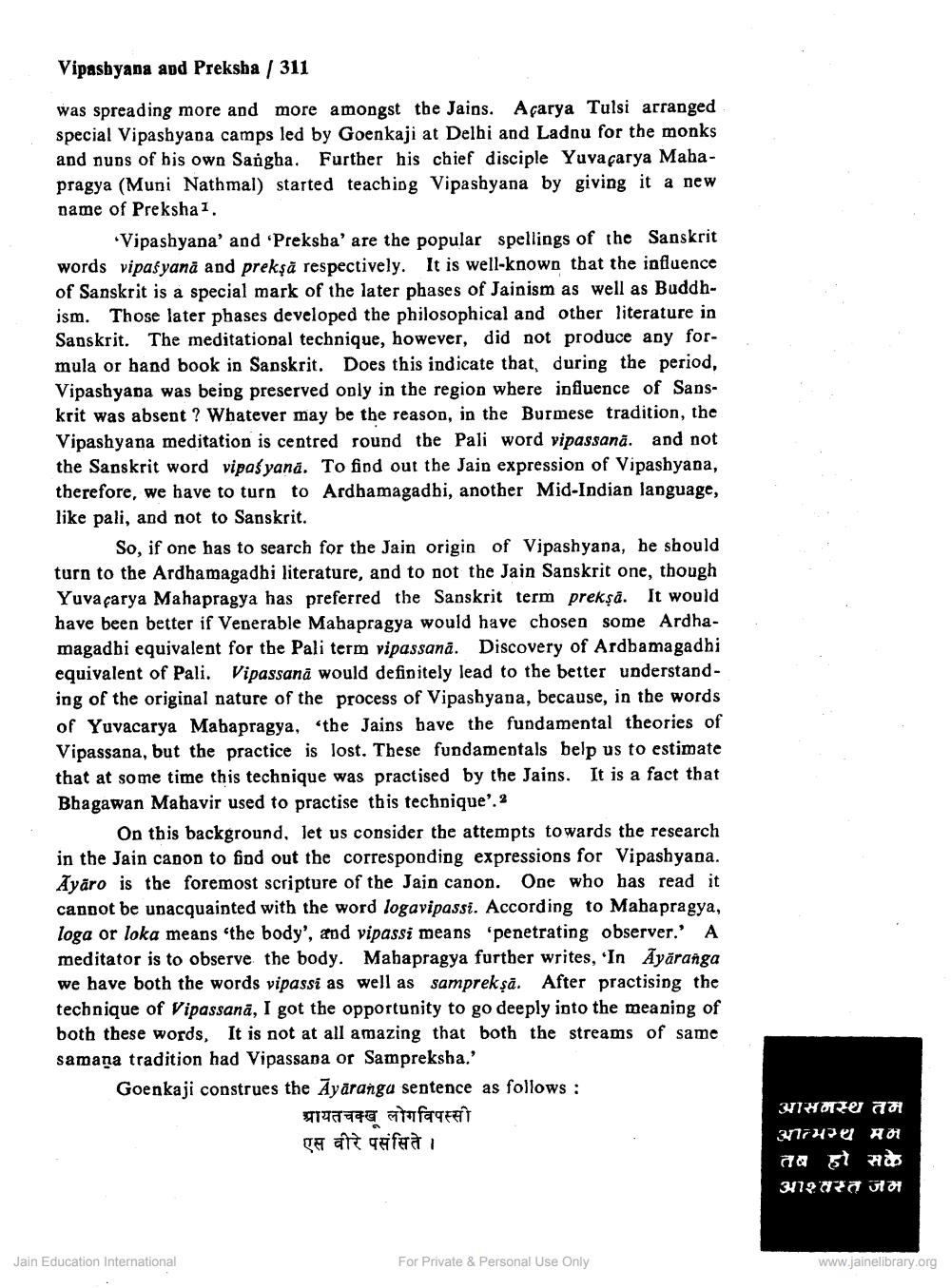Book Title: Vipashyana and Preksha Author(s): J R Joshi Publisher: Z_Umravkunvarji_Diksha_Swarna_Jayanti_Smruti_Granth_012035.pdf View full book textPage 2
________________ Vipasbyana and Preksha / 311 was spreading more and more amongst the Jains. Açarya Tulsi arranged special Vipashyapa camps led by Goenkaji at Delhi and Ladnu for the monks and nuns of his own Sangha. Further his chief disciple Yuvacarya Mahapragya (Muni Nathmal) started teaching Vipashyana by giving it a new name of Preksha 1. Vipashyana' and 'Preksba' are the popular spellings of the Sanskrit words vipas yana and prekşă respectively. It is well-known that the influence of Sanskrit is a special mark of the later phases of Jainism as well as Buddhism. Those later phases developed the philosophical and other literature in Sanskrit. The meditational technique, however, did not produce any formula or hand book in Sanskrit. Does this indicate that, during the period, Vipashyapa was being preserved only in the region where influence of Sanskrit was absent? Whatever may be the reason, in the Burmese tradition, the Vipashyana meditation is centred round the Pali word vipassanā. and not the Sanskrit word vipaśyană. To find out the Jain expression of Vipashyana, therefore, we have to turn to Ardbamagadbi, another Mid-Indian language, like pali, and not to Sanskrit. So, if one has to search for the Jain origin of Vipashyana, he should turn to the Ardhamagadhi literature, and to not the Jain Sanskrit one, though Yuvacarya Mahapragya has preferred the Sanskrit term prekşå. It would have been better if Venerable Mahapragya would have chosen some Ardhamagadhi equivalent for the Pali term vipassanā. Discovery of Ardbamagadhi equivalent of Pali. Vipassana would definitely lead to the better understanding of the original nature of the process of Vipashyana, because, in the words of Yuvacarya Mabapragya, "the Jains have the fundamental theories of Vipassana, but the practice is lost. These fundamentals belp us to estimate that at some time this technique was practised by the Jains. It is a fact that Bhagawan Mahavir used to practise this technique'. 2 On this background, let us consider the attempts towards the research in the Jain canon to find out the corresponding expressions for Vipashyana. Āyāro is the foremost scripture of the Jain canon. One who has read it cannot be unacquainted with the word logavipassi. According to Mahapragya, loga or loka means "the body', and vipassi means 'penetrating observer.' A meditator is to observe the body. Mabapragya further writes, 'In Āyäranga we have both the words vipassi as well as sampreksā. After practising the technique of Vipassanā, I got the opportunity to go deeply into the meaning of both these words. It is not at all amazing that both the streams of same samaņa tradition had Vipassana or Sampreksha.' Goenkaji construes the Zyäranga sentence as follows: प्रायतचक्ख लोगविपस्सी एस वीरे पसंसिते। आसनस्थ तम 377747e An तब हो सके 3120ra tot Jain Education International For Private & Personal Use Only www.jainelibrary.orgPage Navigation
1 2 3 4 5 6 7 8 9 10 11 12 13
